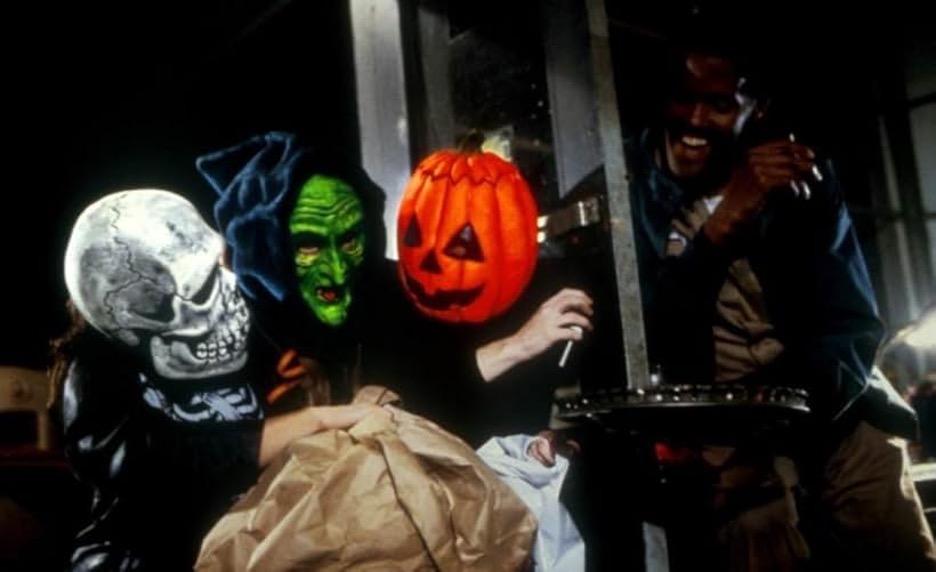The night is Oct. 23, 1982. A man runs down the street, holding a Jack-O-Lantern mask close to his chest. Behind him is a mysterious figure in pursuit: distinctly walking, not running.
The man rounds the corner, hiding in the parking lot of a dark, eerily silent auto shop. This brief moment of comfort and safety doesn’t last long before he is attacked by the mysterious figure – rather, figures. The pursuers are revealed to be blank-faced men in sophisticated gray suits.
42 years later, on Oct. 4, 2024, the audience’s reaction is a mix of confusion, disappointment and excitement. The title of the film is “Halloween III,” so where is Michael Myers?
“Halloween III: Season of the Witch” is the third installment of the “Halloween” franchise, yet the only film in the series not to include the series’ iconic villain, serial killer Michael Myers. Directed by Tommy Lee Wallace, the film was released on Oct. 22, 1982, to negative reviews from critics who panned the absence of Myers.
The film follows Dr. Daniel Challis, portrayed by Tom Atkins, and Ellie Grimbridge, portrayed by Stacey Nelkin, as they work to uncover the mystery surrounding Grimbridge’s father’s death, they are led to a small town responsible for producing deadly Halloween masks. Along the way, they are pursued by killer businessmen-like robots.
“Halloween III” takes a significant departure from the slasher genre of the previous films, instead favoring science fiction elements. After the first two installations and the “death” of Michael Myers, the franchise’s creators, John Carpenter and Debra Hill, envisioned turning the franchise into an anthology series based on different incidents happening on Halloween night because they had no interest in resurrecting the famed slasher. However, they did not anticipate just how much audiences would disapprove of his absence, which caused the anthology concept to be scrapped in favor of bringing back Myers for “Halloween 4: The Return of Michael Myers.”
On its own, the film works. It’s a charming self-contained horror story with fun twists and chilling scares. The premise is original, something uncommon within the horror genre. Uncovering the mystery at the plot’s center is a wonderful ride, as the audience must piece together what is going on along with the characters themselves.
The reality is that the film suffers from the “Halloween” name, carrying the ghost of this gargantuan franchise throughout its runtime. Casual fans are left confused, because the franchise neither explains why Myers is no longer around nor why this film is even part of the continuity.
John Carpenter’s score, as always, makes the film. Carpenter’s composing stands out in any of his projects, as his filmmaking talent lies in creating the most fitting, unsettling theme songs. The score of “Halloween III” is no exception: it fits the film’s sci-fi aesthetic with its eight-bit, synth-heavy production.
The film also introduces its central jingle early on. It goes:
“Eight more days ’til Halloween / Halloween, Halloween / Eight more days ’til Halloween/ Silver Shamrock.”
The jingle is catchy, eerie and sets the tone immediately. One of the film’s central themes is the generally exploitative nature of capitalism, and in this sense, it literally comes at the expense of the consumers. The jingle activates Silver Shamrock’s masks, killing the wearer in brutal fashions.
Despite the clear controversy imposed by the absence of Myers, this is not the only reason the film flopped. The plot is somewhat convoluted and at times hard to follow. The villainous Silver Shamrock corporation’s motivations for killing thousands of people across the country are unclear, even by the end of the film. Yet, the creative twists almost make you forget about the inconsistencies that follow the plot.
Overall, “Halloween III: Season of the Witch” deserves to be included in the expansive canon of classic ‘80s horror films. It may not come close to the aura surrounding iconic films like “Friday the 13th,” “A Nightmare on Elm Street” or the original “Halloween,” but it certainly doesn’t deserve its reputation as the black sheep of the “Halloween” franchise. Had this film been released as “Season of the Witch” by itself, I’m sure it would be remembered much more fondly.
Gustavo Atencio Flores can be reached at [email protected].




















